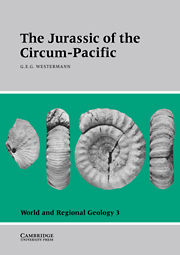Book contents
- Frontmatter
- Contents
- List of contributors
- Preface
- Acknowledgments
- Introduction
- Part I Time scales
- Part II Circum-Pacific base map
- Part III Regional geology and stratigraphy
- 4 Western Canada and United States
- 5 Meso-America
- 6 Western South America and Antarctica
- 7 Australasia
- 8 Indonesia and Papua New Guinea
- 9 Southeast Asia and Japan
- 10 Eastern China
- 11 Eastern Russia
- Part IV Biochronology
- Part V Biogeography
- Part VI Climatology and oceanography
- Appendix: Biochronology and atlas with index and guide fossils
- General Index
- Index of Guide- and Indexfossils
11 - Eastern Russia
Published online by Cambridge University Press: 04 August 2010
- Frontmatter
- Contents
- List of contributors
- Preface
- Acknowledgments
- Introduction
- Part I Time scales
- Part II Circum-Pacific base map
- Part III Regional geology and stratigraphy
- 4 Western Canada and United States
- 5 Meso-America
- 6 Western South America and Antarctica
- 7 Australasia
- 8 Indonesia and Papua New Guinea
- 9 Southeast Asia and Japan
- 10 Eastern China
- 11 Eastern Russia
- Part IV Biochronology
- Part V Biogeography
- Part VI Climatology and oceanography
- Appendix: Biochronology and atlas with index and guide fossils
- General Index
- Index of Guide- and Indexfossils
Summary
INTRODUCTION
Diastrophism
The Jurassic of eastern Russia is part of the Mesozoic tectonosedimentary megacycle, from Late Triassic to Neocomian, which formed the Mesozoids of Northeast Asia and laid the foundations of its present structural plan. The Jurassic changed the geodynamic setting from active geoclinal to continentalization, except for the Pacific margin, where new geoclines were initiated the close of the Jurassic.
Lower and Middle Jurassic deposition occurred during the major cycle of geoclinal evolution of the Mesozoids (North-East Russia: Yukagir cycle), and it comprises a single structural complex together with the Upper Triassic (commonly Norian) deposits. The lower boundary of this complex in the North-East is characterized by hiatuses of differing lengths and minor structural changes (Figure 11.1). In areas of stable down-warping (Oldzhoi and Inyali–Debin Troughs), a weak compressional phase at the beginning of the Yukagir cycle resulted in small thrusts and olistostromes (Parfenov 1984). In Far East Russia, the emplacement this complex was preceded by a major restructuring accompanied by folding (Figure 11.1).
The upper boundary of the Yukagir cycle is almost ubiquitously marked by angular and stratigraphic uncomformities. This regressive phase was of long duration. In the North-East, uncomformities are most distinct in the Bathonian, and less pronounced in the Oxfordian. In the Far East, the first folding occurred in the middle Bajocian and the main phase in the Callovian; the latter is associated with a total inversion of most of the Amur-Okhotsk Geocline.
- Type
- Chapter
- Information
- The Jurassic of the Circum-Pacific , pp. 225 - 246Publisher: Cambridge University PressPrint publication year: 1993
- 4
- Cited by

